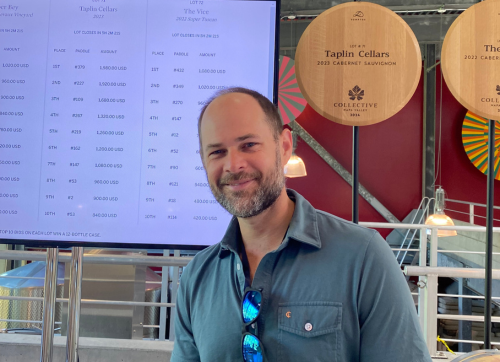What kind of work are you currently doing with the vineyards?
If you read my previous interview, you might remember that I’m relatively new to viticulture. However, the decisions made now will affect my family for the next twenty to thirty years, so I want to do everything I possibly can to make sure we make decisions aligned with our values and the sustainability of our operation.
On example is that recently our vineyard managers finished replanting a section that we call Taplin 1. The vines we replaced were planted around 1999, and were the source for our best Cabernet Sauvignon, which goes into the wine we simply call Taplin. There’s an ancient riverbed that runs through there just below the surface that creates great conditions for Cabernet.
We needed to replant that section due to decreasing yields, disease pressure, and the need for more drought-tolerant rootstock. Some of the key decisions included vine spacing, row orientation, and canopy style. Each of these have been discussed and tailored to our conditions here, right where we are, and I’ve been excited by the opportunity to learn by participating in all the decision making around this new block.
What sort of efforts are you leading with the vineyards in regards to sustainability, and why is that important to you?
Thankfully, this ranch already has a start on sustainability in the form of a Fish Friendly Farming certification, but we want to do more.
One thing my generation has asked about in the past is the use of chemical herbicides on our property. We want the ecosystem and the workers to be as safe as possible. That triggered a deeper inquiry on my part – what alternatives do we have, what are the cost implications of those, and how effective are they? Our vineyard managers were super helpful in talking me through that, including what the economics are behind each alternative, and what the impacts on the wine will be.
One thing I like about the approach that Julien, our winemaker, takes is that he tries to get out of the way of whatever went on in the vineyard each year and let the wine express itself. Managing the sustainability of the property is just one more factor helping us do that.
Another effort is that we’ve set the new vineyard up in a way that is much more friendly to mechanical weed prevention, with more steel protecting the young vines so that an implement behind the tractor can go in under the vine and cut them down. We’re also planning to install bird boxes for swallows, bluebirds, and owls to promote those means of pest management.
What do you see as the future for the vineyards, and what would you like to see happen overall?
In regards to the future, aside from the basic questions and risks posed by climate change, I’m especially interested in water efficiency. I think we have a lot of work to do there and it’s only going to get more scarce. Technology could help us send water where it’s needed in the vineyard and hold back in places where it’s not.
But let’s end on a positive note! I’d like someday to get the Napa Green certification. It has viticultural, operational, and social justice requirements that are a good baseline to work from. During my time as one of the temporary stewards of this property, I want to feel like I did as much as I could to ensure its long-term health and the wellbeing of everyone and everything that lives and works here.
One more question! What is your favorite Taplin wine, and what do you pair it with?
Back to Recent Updates
